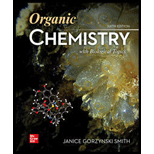
Concept explainers
(a)
Interpretation: The change in the rate of an E2 reaction is to be stated when the concentration of
Concept introduction: E2 type of reaction follows second order kinetics in which the rate depends on both the reactants. The rate law equation for E2 reaction is expressed as,
(b)
Interpretation: The change in the rate of an E2 reaction is to be stated when the concentration of base is halved.
Concept introduction: E2 type of reaction follows second order kinetics in which the rate depends on both the reactants. The rate law equation for E2 reaction is expressed as,
(c)
Interpretation: The change in the rate of an E2 reaction is to be stated when the solvent is changed from
Concept introduction: E2 reactions are usually preferred in
(d)
Interpretation: The change in the rate of an E2 reaction is to be stated when the leaving is changed from
Concept introduction: A leaving group bigger in size is preferred as it leaves easily and fast while a smaller leaving group leaves with difficulty and slow.
(e)
Interpretation: The change in the rate of an E2 reaction is to be stated when the base is changed from
Concept introduction: Strong base is more efficient in proton abstraction and hence, it is more preferred in E2 type of reactions.
(f)
Interpretation: The change in the rate of an E2 reaction is to be stated when the the alkyl halide is changed from
Concept introduction: The rate of E2 reaction depends on the halide being used. A halide in which carbon attached to the leaving group has more number of alkyl groups is usually preferred.
Want to see the full answer?
Check out a sample textbook solution
Chapter 8 Solutions
ORGANIC CHEMISTRY W/BIOLOGICAL TOPICS
- What is the name of the following compound? SiMe3arrow_forwardK Draw the starting structure that would lead to the major product shown under the provided conditions. Drawing 1. NaNH2 2. PhCH2Br 4 57°F Sunny Q Searcharrow_forward7 Draw the starting alkyl bromide that would produce this alkyne under these conditions. F Drawing 1. NaNH2, A 2. H3O+ £ 4 Temps to rise Tomorrow Q Search H2arrow_forward

 Organic Chemistry: A Guided InquiryChemistryISBN:9780618974122Author:Andrei StraumanisPublisher:Cengage Learning
Organic Chemistry: A Guided InquiryChemistryISBN:9780618974122Author:Andrei StraumanisPublisher:Cengage Learning Organic ChemistryChemistryISBN:9781305580350Author:William H. Brown, Brent L. Iverson, Eric Anslyn, Christopher S. FootePublisher:Cengage Learning
Organic ChemistryChemistryISBN:9781305580350Author:William H. Brown, Brent L. Iverson, Eric Anslyn, Christopher S. FootePublisher:Cengage Learning


